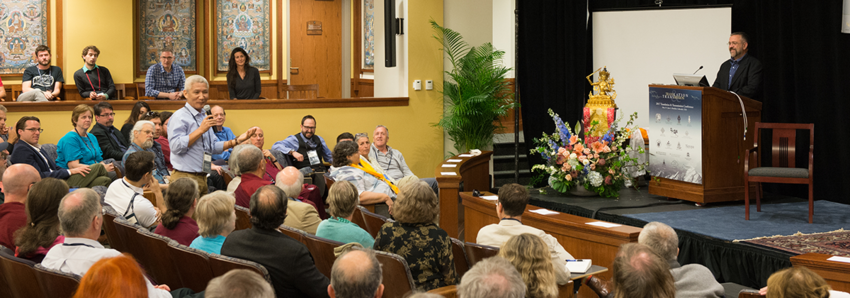((by SublimeText.Mediawiker)) |
((by SublimeText.Mediawiker)) |
||
| (94 intermediate revisions by the same user not shown) | |||
| Line 1: | Line 1: | ||
__NOTOC__ | __NOTOC__{{#addbodyclass:no-first-heading}}<div class="d-flex justify-content-end meetings-nav link-no-border offset"> | ||
== Buddha-Nature Discussion at AAR, Denver <br> < | {| | ||
|- | |||
| class="text-right align-top pr-4" | '''Navigate to:''' | |||
| class="align-top" | [[#Buddha-Nature_Discussion_at_AAR.2C_Denver_Dimensions_of_Buddha-Nature:_Considering_the_State_of_the_Field|<i class="fal fa-angle-down fa-sm"></i> Buddha-Nature Discussion at AAR, Denver]] <br> [[#University_of_Vienna_Symposium_Tath.C4.81gatagarbha_Across_Asia:_The_Reception_of_an_Influential_Mah.C4.81y.C4.81na_Doctrine_in_Central_and_East_Asia|<i class="fal fa-angle-down fa-sm"></i> University of Vienna Symposium]] | |||
|} | |||
</div> | |||
= | <h1 class="large">Meetings</h1> | ||
<div class="row"> | |||
<div class="col-lg-2"></div> | |||
<div class="col-lg-8">[[File:Meetings-heading-image.png|850px|class=meet-head-img depth-1 border-thick|link=|]]</div> | |||
</div> | |||
==University of Vienna Symposium== | {{Meeting | ||
We invite you to join with other scholars to discuss buddha-nature thought and Tathāgatagarbha Across Asia at a symposium, co-hosted by the University of Vienna and Tsadra Foundation, taking place at the University of Vienna, shortly after next year’s International Association of Tibetan Studies conference. Tathāgatagarbha doctrine continues to be of interest to academics and traditional scholars and practitioners of Buddhism around the world and a recent series of books, articles, and meetings have brought new energy and interesting information to light that requires continued discussion and analysis. | |MeetingName=Buddha-Nature Discussion at AAR, Denver | ||
|MeetingTitle=Dimensions of Buddha-Nature: Considering the State of the Field | |||
|MeetingIntro=A small gathering after the American Academy of Religion Conference this year discusses issues and ideas related to buddha-nature teachings and tathāgatagarbha theory in anticipation of a formal symposium at the University of Vienna directly after IATS (International Association of Tibetan Studies) in 2019. The goal of the meeting is to incite and record interesting conversations and brainstorm areas to explore for further research. | |||
|MeetingLeftLogo=File:Tsadra Logo Master 1000.png | |||
|pxLeft=4 | |||
|MeetingLeftLogoLabel=Tsadra Foundation | |||
|MeetingRightLogo=File:Pmc logo.png | |||
|pxRight=0 | |||
|MeetingTimeDate=3:00 p.m., Tuesday, November 20, 2018 | |||
|MeetingLocation=[https://goo.gl/maps/ggV12fQ3xeu Padmasambhava Meditation Center] | |||
|MeetingDescription=Scholars have studied buddha-nature and the Ratnagotravibhāga (Uttaratantra) since the early days of Buddhist Studies in the West. The first translation in English was by Obermiller (1931), from the Sanskrit and Tibetan, and a second by Takasaki (1958), who worked from the Sanskrit, Tibetan, and Chinese. Ruegg published numerous studies of tathāgathagarbha-theory in India and Tibet beginning with La Théorie du Tathāgatagarbha et du Gotra (1969) up to his Gifford Lectures, Buddha-Nature, Mind and the Problem of Gradualism (1989). Ruegg's work was entirely within the "analytic" tradition of Uttaratantra exegesis. The "meditative" tradition, which is aligned with the Mahāmudrā teachings of the Kagyu and Jonang in Central Asia (and Tendai and Ch'an/Zen in East Asia), has been the focus of most major scholarship since. This includes Klaus-Dieter Mathes' extensive study of Gö Lotsāwa's commentary on the Uttaratantra (Wisdom, 2008) and Karl Brunnhölzl’s translations in When the Clouds Part: The Uttaratantra and its Meditative Tradition as a Bridge between Sūtra and Tantra. Important contributions were also made by Kano, Duckworth, Hookham, Stearns, Zimmerman and others. Most recently we have seen the publication of The Sublime Continuum Supercommentary by Gyaltsap Darma Rinchen (Bo Jiang, AIBS, 2017); the important work of Tsering Wangchuk, The Uttaratantra in the Land of Snows (SUNY, 2017); Higgins and Draszczyk’s Mahāmudrā and the Middle Way: Post-Classical Kagyu Discourses on Mind, Emptiness and Buddha-Nature (WSTB, 2016). The Padmakara Translation Group will soon publish a new translation of the Uttaratantra with commentary in English, while Tsadra Foundation will publish a different commentary in French (Charrier trans. 2018). Mathes and Sheehy will soon come out with The Other Emptiness: Rethinking the Zhentong Buddhist Discourse in India and Tibet (SUNY, 2018). And of course there is important scholarly work about buddha-nature in East Asian Buddhism. Sallie King's early work, Buddha Nature (SUNY, 1991), continues to be an important source for the study of Buddha-nature thought in China. In Japanese Buddhism, tathāgatagarbha has been at the core of debates about "original enlightenment," well documented in Jacqueline Stone's book by the same name (Hawai'i, 2003). Buddha-nature continues to be at the center of contemporary debates—e.g., in regard to "Critical Buddhism," amply documented in Jamie Hubbard and Paul Swanson's Pruning the Bodhi Tree (Hawai'i, 1997). | |||
|MeetingParticipant={{PersonListItem|Karl Brunnhölzl|Nitartha Institute}} | |||
{{PersonListItem|José I. Cabezón|UC, Santa Barbara}} | |||
{{PersonListItem|Douglas Duckworth|Temple University}} | |||
{{PersonListItem|Alexander Gardner|Treasury of Lives}} | |||
{{PersonListItem|Shenpen Hookham|Awakened Heart Sangha}} | |||
{{PersonListItem|Jamie Hubbard|Smith College}} | |||
{{PersonListItem|Roger Jackson|Carleton College, Emeritus}} | |||
{{PersonListItem|Connie Kassor|Lawrence University}} | |||
{{PersonListItem|Sallie B. King|James Madison University}} | |||
{{PersonListItem|John Makransky|Boston College}} | |||
{{PersonListItem|Kurtis Schaeffer|University of Virginia}} | |||
{{PersonListItem|Jacqueline Stone|Princeton University}} | |||
{{PersonListItem|Paul Swanson|Nanzan University}} | |||
{{PersonListItem|Tsering Wangchuk|University of San Francisco}} | |||
}} | |||
{{Meeting | |||
|MeetingName=University of Vienna Symposium | |||
|MeetingTitle=Tathāgatagarbha Across Asia: The Reception of an Influential Mahāyāna Doctrine in Central and East Asia | |||
|MeetingIntro=We invite you to join with other scholars to discuss buddha-nature thought and Tathāgatagarbha Across Asia at a symposium, co-hosted by the University of Vienna and Tsadra Foundation, taking place at the University of Vienna, shortly after next year’s International Association of Tibetan Studies conference. Tathāgatagarbha doctrine continues to be of interest to academics and traditional scholars and practitioners of Buddhism around the world and a recent series of books, articles, and meetings have brought new energy and interesting information to light that requires continued discussion and analysis. | |||
|MeetingLeftLogo=File:Tsadra Logo Master 1000.png | |||
|pxLeft=4 | |||
|MeetingLeftLogoLabel=Tsadra Foundation | |||
|MeetingRightLogo=File:Wien logo.png | |||
|pxRight=0 | |||
|MeetingRightLogoLabel=University of Vienna | |||
|MeetingTimeDate=July, 16-19, 2019 | |||
|MeetingLocation=[https://goo.gl/maps/Wizqi2bWiap The University of Vienna, Austria<br>Institut für Südasien-, Tibet- und Buddhismuskunde] | |||
|MeetingDescription=The tathāgatagarbha doctrine which proposes that all sentient beings are already a “buddha within” or at least have the potential to attain Buddhahood was first largely ignored in Indian scholastic Buddhism, but increasingly attracted the attention of Mahāyāna scholars and became an important, if sometimes controversial, current of Buddhist thought all over Central and East Asia. With the Mahāyāna goal of establishing all sentient beings in Buddhahood, the possibility of enlightenment became a Buddhist axiom of central importance. Either one has to explain the causal process of its production, or accept its primordial existence, for example in terms of a buddha-nature (tathāgatagarbha). The latter also applies, of course, when buddhahood is not taken to be produced from scratch. The way the process of becoming a Buddha is addressed is an ideal touchstone for systematically comparing the philosophical hermeneutical positions of various masters in Central and East Asia. The diversity of views on buddha-nature has its roots already in early Indian Buddhism. Depending on whether one follows the original intent of the Tathāgatagarbhasūtras, or the Yogācāra interpretation of the latter, buddha-nature can refer to either an already fully developed buddha, or the naturally present potential (prakṛtisthāgotra) or natural luminosity of mind, i.e., sentient beings’ ability to become buddhas. In Madhyamaka, buddha-nature was taken either as a teaching of provisional meaning (neyārtha) or simply a synonym of emptiness (i.e., a non-affirming negation). This symposium will look at the differing forms tathāgatagarbha doctrine assumed as its primary Indian scriptural sources were translated and transmitted throughout Central and East Asia and variously interpreted by religious schools in line with their key philosophical positions. Contributions will range from the historical-philological analysis of the primary sources to issues of reconstruction and comparison in the target languages and cultures with particular attention to the role the tathāgatagarbha doctrine played in the development of Buddhist philosophical and religious views both within India and beyond. | |||
==== Meeting Schedule ==== | |||
''These dates will allow for those attending the IATS meeting in Paris to have Bastille Day in Paris, and another day to travel to Vienna before the meeting starts.'' | |||
== | <table class="table"> | ||
< | <tr> | ||
<th>July 16th, 2019 ~ Arrival Day</th> | |||
<td colspan="2">'''5:30 pm''' ~ Evening Welcome Event<br>Keynote Speech with Official Welcome from Klaus-Dieter Mathes</td> | |||
</tr> | |||
<tr> | |||
<th>July 17th, 2019 ~ Presentations</th> | |||
<td>'''9:00 am''' ~ Session 1 <br> '''10:30 am''' ~ Tea Break <br> '''11:00 am''' ~ Session 2 <br> '''12:30 pm''' ~ Lunch</td> | |||
<td>'''2:30 pm''' ~ Session 3 <br> '''4:00 pm''' ~ Tea Break <br> '''4:30 pm''' ~ Session 4 <br> '''6:00 pm''' ~ End of Day</td> | |||
</tr> | |||
<tr> | |||
<th>July 18th, 2019 ~ Presentations</th> | |||
<td>'''9:00 am''' ~ Session 5 <br> '''10:30 am''' ~ Tea Break<br> '''11:00 am''' ~ Session 6 <br> '''12:30 pm''' ~ Lunch</td> | |||
<td>'''2:30 pm''' ~ Session 7 <br> '''4:00 pm''' ~ Tea Break<br> '''4:30 pm''' ~ Session 8<br> '''6:00 pm''' ~ End of Day</td> | |||
</tr> | |||
<tr> | |||
<th>July 19th, 2019 ~ Presentations</th> | |||
<td>'''9:00 am''' ~ Session 9<br> '''10:30 am''' ~ Tea Break<br> '''11:00 am''' ~ Session 10<br> '''12:30 pm''' ~ Lunch</td> | |||
<td>'''2:30 pm''' ~ Session 11<br> '''4:00 pm''' ~ Tea Break<br> '''4:30 pm''' ~ Session 12: Closing Discussion:<br>Reflection on State of the Field <br> '''6:00 pm''' ~ End of Day</td> | |||
</tr> | |||
<tr> | |||
<th>July 20th, 2019 ~ Departure Day</th> | |||
<td colspan="2">Travel</td> | |||
</tr> | |||
</table> | |||
= | |MeetingParticipant={{PersonListItem|Filippo Brambilla|University of Vienna}} | ||
{{PersonListItem|Martina Draszczyk|University of Vienna}} | |||
{{PersonListItem|Douglas Duckworth|Temple University}} | |||
{{PersonListItem|David Higgins|University of Vienna}} | |||
{{PersonListItem|Shenpen Hookham|Awakened Heart Sangha)}} | |||
{{PersonListItem|Bo Jiang|Columbia University}} | |||
{{PersonListItem|Christopher V. Jones|Oxford}} | |||
{{PersonListItem|Kazuo Kano|Koyasan University, Japan}} | |||
{{PersonListItem|Constance Kassor|Lawrence University}} | |||
{{PersonListItem|Klaus-Dieter Mathes|University of Vienna}} | |||
{{PersonListItem|Giacomella Orofino|University of Naples}} | |||
{{PersonListItem|Kurtis Schaeffer|University of Virginia}} | |||
{{PersonListItem|Michael Sheehy|University of Virginia}} | |||
{{PersonListItem|Khenpo Tamphel|University of Vienna}} | |||
{{PersonListItem|Dorji Wangchuk|Hamburg}} | |||
{{PersonListItem|Tsering Wangchuk|University of San Francisco}} | |||
{{PersonListItem|Michael Zimmerman|Hamburg}} | |||
<center>''Representatives from several Buddhist schools will also be presenting.''</center> | |||
}} | |||
Latest revision as of 21:33, 7 October 2018
Meetings
Buddha-Nature Discussion at AAR, Denver
Dimensions of Buddha-Nature: Considering the State of the Field[edit]
3:00 p.m., Tuesday, November 20, 2018
Meeting Description
Scholars have studied buddha-nature and the Ratnagotravibhāga (Uttaratantra) since the early days of Buddhist Studies in the West. The first translation in English was by Obermiller (1931), from the Sanskrit and Tibetan, and a second by Takasaki (1958), who worked from the Sanskrit, Tibetan, and Chinese. Ruegg published numerous studies of tathāgathagarbha-theory in India and Tibet beginning with La Théorie du Tathāgatagarbha et du Gotra (1969) up to his Gifford Lectures, Buddha-Nature, Mind and the Problem of Gradualism (1989). Ruegg's work was entirely within the "analytic" tradition of Uttaratantra exegesis. The "meditative" tradition, which is aligned with the Mahāmudrā teachings of the Kagyu and Jonang in Central Asia (and Tendai and Ch'an/Zen in East Asia), has been the focus of most major scholarship since. This includes Klaus-Dieter Mathes' extensive study of Gö Lotsāwa's commentary on the Uttaratantra (Wisdom, 2008) and Karl Brunnhölzl’s translations in When the Clouds Part: The Uttaratantra and its Meditative Tradition as a Bridge between Sūtra and Tantra. Important contributions were also made by Kano, Duckworth, Hookham, Stearns, Zimmerman and others. Most recently we have seen the publication of The Sublime Continuum Supercommentary by Gyaltsap Darma Rinchen (Bo Jiang, AIBS, 2017); the important work of Tsering Wangchuk, The Uttaratantra in the Land of Snows (SUNY, 2017); Higgins and Draszczyk’s Mahāmudrā and the Middle Way: Post-Classical Kagyu Discourses on Mind, Emptiness and Buddha-Nature (WSTB, 2016). The Padmakara Translation Group will soon publish a new translation of the Uttaratantra with commentary in English, while Tsadra Foundation will publish a different commentary in French (Charrier trans. 2018). Mathes and Sheehy will soon come out with The Other Emptiness: Rethinking the Zhentong Buddhist Discourse in India and Tibet (SUNY, 2018). And of course there is important scholarly work about buddha-nature in East Asian Buddhism. Sallie King's early work, Buddha Nature (SUNY, 1991), continues to be an important source for the study of Buddha-nature thought in China. In Japanese Buddhism, tathāgatagarbha has been at the core of debates about "original enlightenment," well documented in Jacqueline Stone's book by the same name (Hawai'i, 2003). Buddha-nature continues to be at the center of contemporary debates—e.g., in regard to "Critical Buddhism," amply documented in Jamie Hubbard and Paul Swanson's Pruning the Bodhi Tree (Hawai'i, 1997).
Participants
University of Vienna Symposium
Tathāgatagarbha Across Asia: The Reception of an Influential Mahāyāna Doctrine in Central and East Asia[edit]
Meeting Description
The tathāgatagarbha doctrine which proposes that all sentient beings are already a “buddha within” or at least have the potential to attain Buddhahood was first largely ignored in Indian scholastic Buddhism, but increasingly attracted the attention of Mahāyāna scholars and became an important, if sometimes controversial, current of Buddhist thought all over Central and East Asia. With the Mahāyāna goal of establishing all sentient beings in Buddhahood, the possibility of enlightenment became a Buddhist axiom of central importance. Either one has to explain the causal process of its production, or accept its primordial existence, for example in terms of a buddha-nature (tathāgatagarbha). The latter also applies, of course, when buddhahood is not taken to be produced from scratch. The way the process of becoming a Buddha is addressed is an ideal touchstone for systematically comparing the philosophical hermeneutical positions of various masters in Central and East Asia. The diversity of views on buddha-nature has its roots already in early Indian Buddhism. Depending on whether one follows the original intent of the Tathāgatagarbhasūtras, or the Yogācāra interpretation of the latter, buddha-nature can refer to either an already fully developed buddha, or the naturally present potential (prakṛtisthāgotra) or natural luminosity of mind, i.e., sentient beings’ ability to become buddhas. In Madhyamaka, buddha-nature was taken either as a teaching of provisional meaning (neyārtha) or simply a synonym of emptiness (i.e., a non-affirming negation). This symposium will look at the differing forms tathāgatagarbha doctrine assumed as its primary Indian scriptural sources were translated and transmitted throughout Central and East Asia and variously interpreted by religious schools in line with their key philosophical positions. Contributions will range from the historical-philological analysis of the primary sources to issues of reconstruction and comparison in the target languages and cultures with particular attention to the role the tathāgatagarbha doctrine played in the development of Buddhist philosophical and religious views both within India and beyond.
Meeting Schedule
These dates will allow for those attending the IATS meeting in Paris to have Bastille Day in Paris, and another day to travel to Vienna before the meeting starts.
| July 16th, 2019 ~ Arrival Day | 5:30 pm ~ Evening Welcome Event Keynote Speech with Official Welcome from Klaus-Dieter Mathes |
|
|---|---|---|
| July 17th, 2019 ~ Presentations | 9:00 am ~ Session 1 10:30 am ~ Tea Break 11:00 am ~ Session 2 12:30 pm ~ Lunch |
2:30 pm ~ Session 3 4:00 pm ~ Tea Break 4:30 pm ~ Session 4 6:00 pm ~ End of Day |
| July 18th, 2019 ~ Presentations | 9:00 am ~ Session 5 10:30 am ~ Tea Break 11:00 am ~ Session 6 12:30 pm ~ Lunch |
2:30 pm ~ Session 7 4:00 pm ~ Tea Break 4:30 pm ~ Session 8 6:00 pm ~ End of Day |
| July 19th, 2019 ~ Presentations | 9:00 am ~ Session 9 10:30 am ~ Tea Break 11:00 am ~ Session 10 12:30 pm ~ Lunch |
2:30 pm ~ Session 11 4:00 pm ~ Tea Break 4:30 pm ~ Session 12: Closing Discussion: Reflection on State of the Field 6:00 pm ~ End of Day |
| July 20th, 2019 ~ Departure Day | Travel | |





